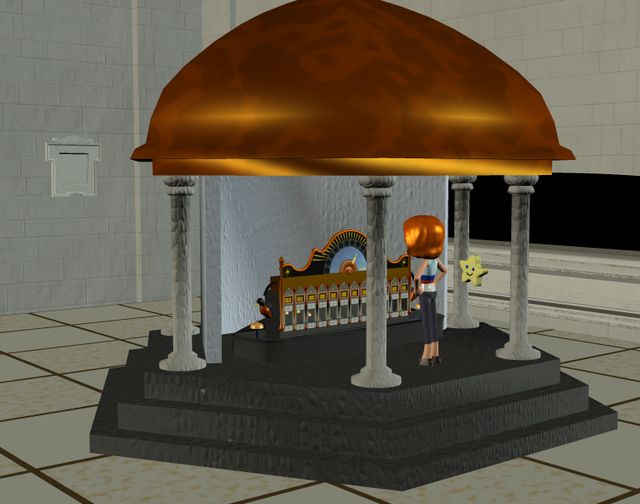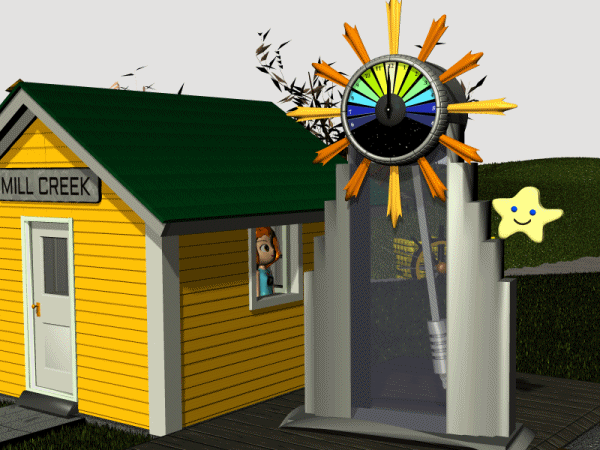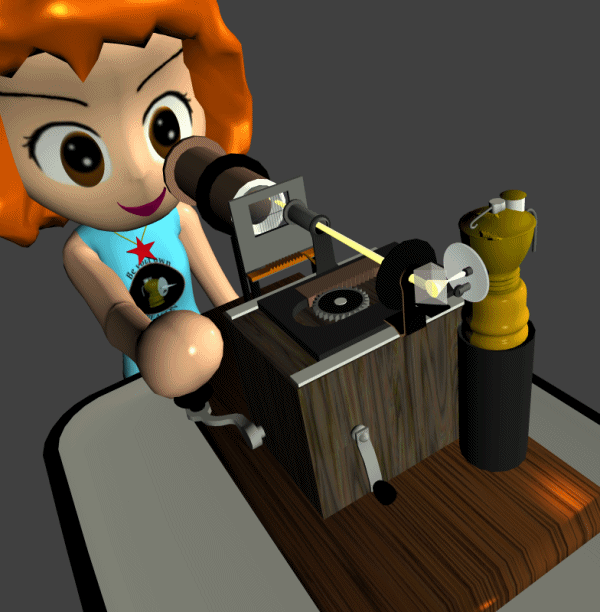Sunday, May 03, 2020
Summing up the Ancestral Clocks
It's time to cinch up the Ancestral Clocks set with a bit of organization and narrative.
First the clocks. I chose these three partly for beauty and partly for non-modern functions. Structured beauty is a crucial immune response to the current overwhelming onslaught of ANTI-structure holocaust.
In the first few centuries of clock development, clocks were luxury items and public monuments. They provided both beauty and entertainment, along with a time reference for public or religious ceremonies. Farms and workshops didn't need clocks. Start when it's light, stop when it's dark or when you're finished.
= = = = =
The Ridhwan is the best of the three for beauty and entertainment. It was a public monument and a reference point for Islamic prayers and holidays.
 The Ridhwan also beats the competition in functionality. You can instantly see how much of the day has been used up, and how much of each hour is used up. Later clocks lost this graphic representation.
= = = = =
The Riefler has an austere delicate beauty, the exact opposite of entertainment.
The Ridhwan also beats the competition in functionality. You can instantly see how much of the day has been used up, and how much of each hour is used up. Later clocks lost this graphic representation.
= = = = =
The Riefler has an austere delicate beauty, the exact opposite of entertainment.
 It was intended as a frequency standard, not a timekeeper, so the hands are not meant to be easily or precisely readable. The hands are separated out for minimum friction. All of the function is focused on the pendulum; even the mini-transit lets you literally focus on the pendulum.
= = = = =
The Fan Clock may have been only an idea. I felt free to improvise, based on a sketch of the fan itself. Like the Ridhwan, the Fan is a public monument with some entertainment value. Also like the Ridhwan, the Fan has an Equation aspect, with the 12 hours of daylight expanding and contracting with the seasons.
It was intended as a frequency standard, not a timekeeper, so the hands are not meant to be easily or precisely readable. The hands are separated out for minimum friction. All of the function is focused on the pendulum; even the mini-transit lets you literally focus on the pendulum.
= = = = =
The Fan Clock may have been only an idea. I felt free to improvise, based on a sketch of the fan itself. Like the Ridhwan, the Fan is a public monument with some entertainment value. Also like the Ridhwan, the Fan has an Equation aspect, with the 12 hours of daylight expanding and contracting with the seasons.
 = = = = =
Here's a demo of all three running through 24 hours from midnight to midnight.
= = = = =
Here's a demo of all three running through 24 hours from midnight to midnight.
 The Ridhwan's 'consumption' is clear in this sequence, and the Fan Clock's representation of sun position is also evident.
The pendulums, and the Riefler second hand, are not 'honest' in this speeded-up animation. The Riefler second hand is speeding too fast to be seen, so the sparse frames give it a classic stagecoach wheel aliasing effect.
= = = = =
I ran into the Elgin observatory by accident while looking at telegraphic time signals. Elgin turned out to be a strong counterforce against modern idiocy. Along with other companies I've discussed before, Elgin followed the Social Economics model, treating its employees decently because it WANTED TO HAVE LIVE EMPLOYEES. Radical and weird and unthinkable idea in today's Share Value Lockdown world. Elgin went beyond Ford and Conoco, basing its business and advertising on the concept of natural measurement.
The Ridhwan's 'consumption' is clear in this sequence, and the Fan Clock's representation of sun position is also evident.
The pendulums, and the Riefler second hand, are not 'honest' in this speeded-up animation. The Riefler second hand is speeding too fast to be seen, so the sparse frames give it a classic stagecoach wheel aliasing effect.
= = = = =
I ran into the Elgin observatory by accident while looking at telegraphic time signals. Elgin turned out to be a strong counterforce against modern idiocy. Along with other companies I've discussed before, Elgin followed the Social Economics model, treating its employees decently because it WANTED TO HAVE LIVE EMPLOYEES. Radical and weird and unthinkable idea in today's Share Value Lockdown world. Elgin went beyond Ford and Conoco, basing its business and advertising on the concept of natural measurement.
 The observatory was the real center of the business AND a nice marketing gimmick. Elgin takes the time from the stars and puts it on your wrist.
Inside the observatory, astronomers made precise dynamic sightings of specific stars, marking the movement of each star along with the ticks of the Riefler standard clock.
The observatory was the real center of the business AND a nice marketing gimmick. Elgin takes the time from the stars and puts it on your wrist.
Inside the observatory, astronomers made precise dynamic sightings of specific stars, marking the movement of each star along with the ticks of the Riefler standard clock.
 The ticks on the chronograph (plotter) were then compared, and the pendulum of the Riefler was adjusted if necessary. The Riefler's ticks were broadcast into the factory's adjustment department, where each clock and watch was calibrated to match the standard ticks.
Even the astronomer had to be calibrated, using the Personal Equation Machine. This simulator moved a known 'artificial star' across a transit with similar markings, and the astronomer ticked the sightings. The delays were then mixed into the complicated arithmetic of the real star transits to make an Equation Of Time.
The ticks on the chronograph (plotter) were then compared, and the pendulum of the Riefler was adjusted if necessary. The Riefler's ticks were broadcast into the factory's adjustment department, where each clock and watch was calibrated to match the standard ticks.
Even the astronomer had to be calibrated, using the Personal Equation Machine. This simulator moved a known 'artificial star' across a transit with similar markings, and the astronomer ticked the sightings. The delays were then mixed into the complicated arithmetic of the real star transits to make an Equation Of Time.
 Equations Of Time were the calibrators and adjusters for all sorts of timekeeping, from the precise star-transit calibrations to the much looser Sun Time vs Sidereal Time adjustments. Most of the Sun Time variations have been lost in the all-digital era; our standard ticks are universally distributed via the net so we no longer need to be conscious of the process.
= = = = =
Links for the Ancestral Clocks set so far:
The magnificent Ridhwan.
Clock dance.
Crude water clock.
Observatories
The Elgin observatory.
The Riefler clock.
Personal Equation Machines.
More Elgin ads.
Fan clocks.
Summing up.
= = = = =
And finally, the Poser set released at ShareCG.
Equations Of Time were the calibrators and adjusters for all sorts of timekeeping, from the precise star-transit calibrations to the much looser Sun Time vs Sidereal Time adjustments. Most of the Sun Time variations have been lost in the all-digital era; our standard ticks are universally distributed via the net so we no longer need to be conscious of the process.
= = = = =
Links for the Ancestral Clocks set so far:
The magnificent Ridhwan.
Clock dance.
Crude water clock.
Observatories
The Elgin observatory.
The Riefler clock.
Personal Equation Machines.
More Elgin ads.
Fan clocks.
Summing up.
= = = = =
And finally, the Poser set released at ShareCG.
 The Ridhwan also beats the competition in functionality. You can instantly see how much of the day has been used up, and how much of each hour is used up. Later clocks lost this graphic representation.
= = = = =
The Riefler has an austere delicate beauty, the exact opposite of entertainment.
The Ridhwan also beats the competition in functionality. You can instantly see how much of the day has been used up, and how much of each hour is used up. Later clocks lost this graphic representation.
= = = = =
The Riefler has an austere delicate beauty, the exact opposite of entertainment.
 It was intended as a frequency standard, not a timekeeper, so the hands are not meant to be easily or precisely readable. The hands are separated out for minimum friction. All of the function is focused on the pendulum; even the mini-transit lets you literally focus on the pendulum.
= = = = =
The Fan Clock may have been only an idea. I felt free to improvise, based on a sketch of the fan itself. Like the Ridhwan, the Fan is a public monument with some entertainment value. Also like the Ridhwan, the Fan has an Equation aspect, with the 12 hours of daylight expanding and contracting with the seasons.
It was intended as a frequency standard, not a timekeeper, so the hands are not meant to be easily or precisely readable. The hands are separated out for minimum friction. All of the function is focused on the pendulum; even the mini-transit lets you literally focus on the pendulum.
= = = = =
The Fan Clock may have been only an idea. I felt free to improvise, based on a sketch of the fan itself. Like the Ridhwan, the Fan is a public monument with some entertainment value. Also like the Ridhwan, the Fan has an Equation aspect, with the 12 hours of daylight expanding and contracting with the seasons.
 = = = = =
Here's a demo of all three running through 24 hours from midnight to midnight.
= = = = =
Here's a demo of all three running through 24 hours from midnight to midnight.
 The Ridhwan's 'consumption' is clear in this sequence, and the Fan Clock's representation of sun position is also evident.
The pendulums, and the Riefler second hand, are not 'honest' in this speeded-up animation. The Riefler second hand is speeding too fast to be seen, so the sparse frames give it a classic stagecoach wheel aliasing effect.
= = = = =
I ran into the Elgin observatory by accident while looking at telegraphic time signals. Elgin turned out to be a strong counterforce against modern idiocy. Along with other companies I've discussed before, Elgin followed the Social Economics model, treating its employees decently because it WANTED TO HAVE LIVE EMPLOYEES. Radical and weird and unthinkable idea in today's Share Value Lockdown world. Elgin went beyond Ford and Conoco, basing its business and advertising on the concept of natural measurement.
The Ridhwan's 'consumption' is clear in this sequence, and the Fan Clock's representation of sun position is also evident.
The pendulums, and the Riefler second hand, are not 'honest' in this speeded-up animation. The Riefler second hand is speeding too fast to be seen, so the sparse frames give it a classic stagecoach wheel aliasing effect.
= = = = =
I ran into the Elgin observatory by accident while looking at telegraphic time signals. Elgin turned out to be a strong counterforce against modern idiocy. Along with other companies I've discussed before, Elgin followed the Social Economics model, treating its employees decently because it WANTED TO HAVE LIVE EMPLOYEES. Radical and weird and unthinkable idea in today's Share Value Lockdown world. Elgin went beyond Ford and Conoco, basing its business and advertising on the concept of natural measurement.
 The observatory was the real center of the business AND a nice marketing gimmick. Elgin takes the time from the stars and puts it on your wrist.
Inside the observatory, astronomers made precise dynamic sightings of specific stars, marking the movement of each star along with the ticks of the Riefler standard clock.
The observatory was the real center of the business AND a nice marketing gimmick. Elgin takes the time from the stars and puts it on your wrist.
Inside the observatory, astronomers made precise dynamic sightings of specific stars, marking the movement of each star along with the ticks of the Riefler standard clock.
 The ticks on the chronograph (plotter) were then compared, and the pendulum of the Riefler was adjusted if necessary. The Riefler's ticks were broadcast into the factory's adjustment department, where each clock and watch was calibrated to match the standard ticks.
Even the astronomer had to be calibrated, using the Personal Equation Machine. This simulator moved a known 'artificial star' across a transit with similar markings, and the astronomer ticked the sightings. The delays were then mixed into the complicated arithmetic of the real star transits to make an Equation Of Time.
The ticks on the chronograph (plotter) were then compared, and the pendulum of the Riefler was adjusted if necessary. The Riefler's ticks were broadcast into the factory's adjustment department, where each clock and watch was calibrated to match the standard ticks.
Even the astronomer had to be calibrated, using the Personal Equation Machine. This simulator moved a known 'artificial star' across a transit with similar markings, and the astronomer ticked the sightings. The delays were then mixed into the complicated arithmetic of the real star transits to make an Equation Of Time.
 Equations Of Time were the calibrators and adjusters for all sorts of timekeeping, from the precise star-transit calibrations to the much looser Sun Time vs Sidereal Time adjustments. Most of the Sun Time variations have been lost in the all-digital era; our standard ticks are universally distributed via the net so we no longer need to be conscious of the process.
= = = = =
Links for the Ancestral Clocks set so far:
The magnificent Ridhwan.
Clock dance.
Crude water clock.
Observatories
The Elgin observatory.
The Riefler clock.
Personal Equation Machines.
More Elgin ads.
Fan clocks.
Summing up.
= = = = =
And finally, the Poser set released at ShareCG.
Equations Of Time were the calibrators and adjusters for all sorts of timekeeping, from the precise star-transit calibrations to the much looser Sun Time vs Sidereal Time adjustments. Most of the Sun Time variations have been lost in the all-digital era; our standard ticks are universally distributed via the net so we no longer need to be conscious of the process.
= = = = =
Links for the Ancestral Clocks set so far:
The magnificent Ridhwan.
Clock dance.
Crude water clock.
Observatories
The Elgin observatory.
The Riefler clock.
Personal Equation Machines.
More Elgin ads.
Fan clocks.
Summing up.
= = = = =
And finally, the Poser set released at ShareCG.
Labels: Entertainment, Equipoise, Metrology
